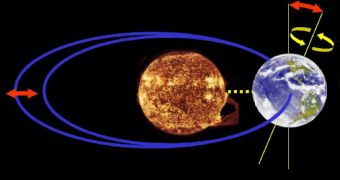Currently, we play with the clime of our planet, hoping for the minimum results. Ice core probes from deep drills made on the Antarctica, employed to investigate climate during the past hundreds of thousands of years, revealed that warm periods corresponded with high carbon dioxide levels and cold ones with low levels of this main greenhouse gas. For 2 million years, our planet experiences Ice Ages and in between, warmer periods, called interglacials. We are now in an interglacial (even if man-made global warming seems to change this).
The cycles glacial-interglacial were explained by the Serbian geophysicist Milutin Milankovitch. He said the ellipse run by Earth around the Sun varies in time, modifying the energy amount received by our planet from its star. The tilt of the Poles is also slightly modified and the Sun is not exactly in the center of the ellipse. Combining these factors, Milankovitch got a periodicity of 100,000 years, corresponding approximatively to the duration of recorded Ice Ages and interglacials. The last glaciation ended 10,000 years ago.
But Earth has also its millennial whims. In fact, Europe passed through a miniglaciation from XVth century till about 1850. The paintings of the Flemish painter Peter Bruegel depict frozen snowy winters in a Belgium that rarely knows winter snow currently. In fact, this miniglaciation finished the Viking settlements on Greenland.
There are many hypotheses trying to explain these microchanges, from solar spots to oceanic conditions. It is known that the oceans act like a thermostat of the Earth, absorbing huge amounts of energy and distributing it after that slowly to the poles. The Ocean makes felt its role in the global clime in the best way through El Ninio, a 4-5 years cycle, which turns upside down clime on large areas: typhoons and floods on desert areas of eastern Pacific and severe droughts in normally wet zones of the western Pacific. This phenomenon is due to a change on the trade winds cycle on the Pacific.
Some researchers estimate that in 5,000 years, we should enter naturally into a glacial period, but with the current global warming, this seems less likely.
From 1850 to 1980, the carbon dioxide dumped by people through the burning of the fossil fuels into the atmosphere raised its level by 25 % (from 0.028 % to 0.034%) while till 2030 it will be more than the double of its percentage at the beginning of the industrial era. The Earth's temperature is already with over 0.5 degrees C higher, and the sea level has risen with over 15 cm (0.5 ft). The Earth's temperature will experience a 2-4 degrees C rise, but this will affect less the tropics and more the high latitude, where polar ice caps are located. This is extremely high, as even during the coldest Ice Ages, Earth temperature did not drop more than 4 degrees below the present one.
By 2030 the sea level could be already 75 cm (2.5 ft) higher, which will create huge problems in the low areas of the world.

 14 DAY TRIAL //
14 DAY TRIAL //